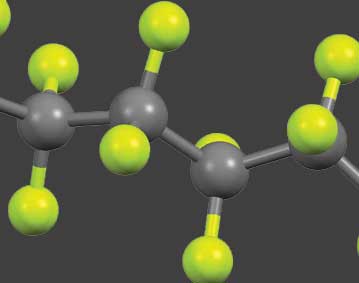
Why Not Teflon?
- posted by: NanoSlick
- No Comments
Why are products based on Teflon not the wisest choice for the environment?
Teflon, which is known chemically as polytetrafluoroethylene, or PTFE, is a plasticlike substance made up of a complex mixture of perfl uorinated chemicals (PFCs). Unlike known environmental villains such as DDT and PCBs, PFCs are not generally volatile – in other words, they do not become easily airborne and so tend not to migrate long distances. In addition, to produce a substance such as Teflon, these compounds are usually ‘locked’ into polymers – chains of molecules – so it was assumed that they couldn’t leak into the environment. Even if they did, it was assumed that they wouldn’t break down; and even if they did, it was assumed that they were biologically inert. All of these assumptions are being proved wrong.
Scientific data shows that PFCs fulfil every single criterion for persistent bioaccumulative toxins: that is they do not biodegrade, they accumulate in people, animals and the environment, and they have been shown in laboratory tests to be toxic to mammals. Although there are nearly 100 known PFCs, only two have been studied in any depth: perfluorooctane sulfonate (PFOS), a breakdown product of the stain-repellent Scotchguard (now withdrawn from sale), and perfluorooctanoic acid (PFOA), a breakdown product of Tefl on. Both have been found in the blood of nearly every human tested, as well as in animals in the Arctic and Atlantic oceans.
NanoSlick™ produces no products based on Teflon, all our products are formulated with Tungsten Disulfide WS2, which is 100% environmentally friendly! You would be surprise how many well-known lubricants are formulated with Teflon or commonly hidden under the PTFE name.
Even Dupont discontinued it’s own DuPont Teflon® Bearing Grease several years ago.
A toxic trail
Once in the environment, PFCs have been shown to accumulate in organs like the liver, gall bladder and thyroid gland. In primates, including humans, exposure to one of Teflon’s breakdown products, PFOA, has led to an underactive thyroid (hypothyroidism). A prolonged state of hypothyroidism is a risk for obesity, insulin resistance and thyroid cancer.
Laboratory studies also show that PFOA is toxic to at least nine types of cells that regulate immune function. Cells in the spleen and thymus – both critical to immune function – are particularly vulnerable, and humans exposed to PFOA show reduced immune function. Most recently, PFOA has been linked to raised cholesterol and triglyceride (blood fat) levels in factory workers, and in animals to potentially dangerous changes in the size and weight of several important organs such as the brain, liver and spleen. PFOA is also thought to be a hormone disrupter.
In 2005, the US Environmental Protection Agency classified PFOA as a ‘likely human carcinogen’ and asked industry to work towards eliminating PFOA and related chemicals from emissions and products by no later than 2015.
The quickest way to degrade Teflon is through high temperatures. Such is the paucity of research on how it degrades, however, that nobody is entirely sure what else might cause it to break down. Or even how it, and its constituents, get into the environment. Being ‘locked’ in a cookware coating is one thing, but being used on a fishing reel is another. Reel lube is not meant to stay in place for 20 years. With normal wear and tear and friction the lube will come off – even if the product contains glue-like tackifiers (which are also petrochemical-based irritants). Normal use of the reel in both freshwater and saltwater and the lube will begin to wash away into our oceans, lakes, and rivers or on to the land.
Maybe you think the reel lube is not much of an environmental priority, but it’s worth seeing the bigger picture of lubricant oils, which are widely used in manufacturing and mechanical maintenance. It is estimated that 40 per cent of all lubricants are released into the environment. Their ‘proper’ disposal usually includes either burning or being put into landfill, or recycled, each of which has its own environmental impact. Burning releases toxic soot into the air, which is a hazard when inhaled or when it lands on crops or in water supplies, and landfill runs the risk of toxic chemicals seeping into groundwater.
The Environment Agency and WRAP (Waste & Resources Action Programme) are currently running a consultation on the best ways to dispose of waste lubricant oil (though reel lube is not included in this consultation). This is primarily concerned with turning used lubricating oils into a cheaper alternative to virgin fossil fuels – lubricating oils are made from waste fuel, so returning them to fuel does complete a cycle of sorts, but it is also energy-intensive and polluting. Recycling is also problematic because of all the additives in lubricant oils.
So why its continued use?
The answer is simple, just look at some of the manufacturer Material
Safety Data Sheets. They state; “Not regarded as a health hazard under
current legislation.” , notice that does not state IT IS NOT regarded as
a health hazard, just that it isn’t under current legislation.
